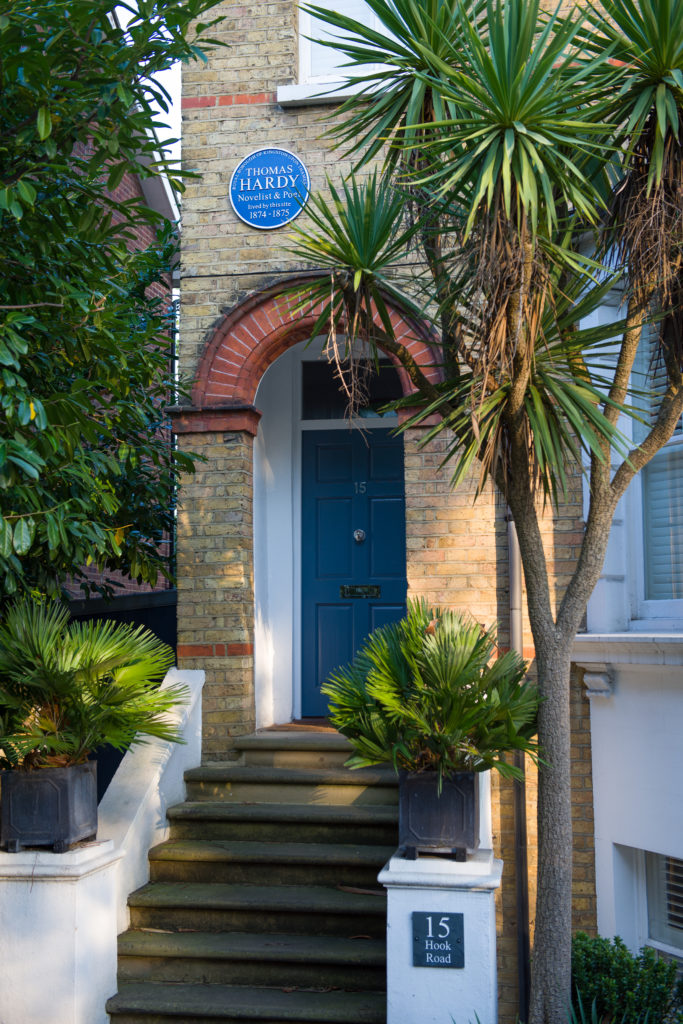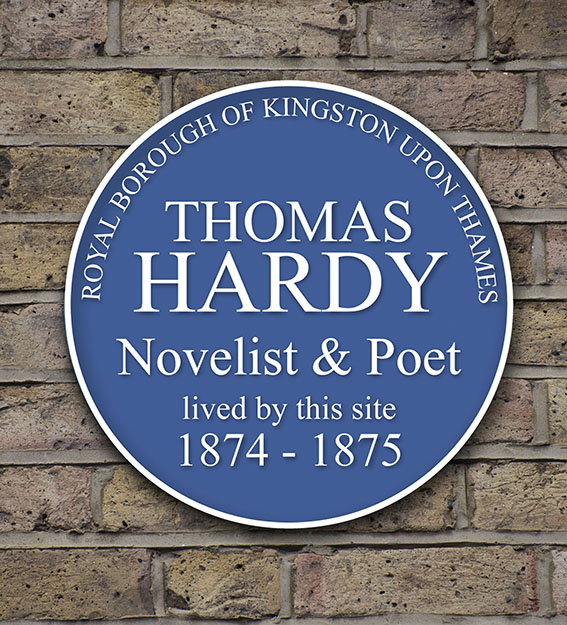
Hook Road in Surbiton is dotted with a few handsome villas that survive from the 1870s. One of these, a Victorian townhouse at number 15, bears a blue plaque for the famous novelist and poet Thomas Hardy.
It comes as a surprise to many to learn that Thomas Hardy was living in this vicinity in the mid-1870s. And perhaps even more surprising to know that Hardy’s famous novel, Far from the Madding Crowd, was published at the time he lived here in Surbiton. Age 33 and newly married to his wife, Emma, the couple were starting their married life in lodgings here. Far from the Madding Crowd was about to launch Thomas Hardy’s career.
A further point of interest for the neighbourhood is that Hardy wrote poems about Surbiton, Southborough and Long Ditton whilst living here.
History of the neighbourhood
Hardy’s home at St David’s Villa was one of a row of houses built circa 1872 on the Hook Road, then also known as Southborough Road. This was a turnpike road, and the row of villas stood near the Southborough turnpike toll gate at the junction of Ditton and Southborough Roads, by the Maypole Inn. The row of villas were new-builds at the time Hardy and his wife were living here in 1874-5. This whole area to the southwest of central Surbiton was called Southborough, stretching all the way to the southern hamlet of Hook and bordering Tolworth to the east, which at that time was undeveloped common land. What in modern times is the conservation heart of Southborough was in Hardy’s time still 200 acres of private parkland surrounding Southborough House, a mansion designed by the architect John Nash in 1808.
There were no house numbers on the Hook / Southborough Road during the Victorian era, but the modernday road numbering positions Hardy’s house at the location of 13 Hook Road. Sadly, St David’s Villa is no longer there. Most of the Victorian houses along the Hook Road, including Hardy’s house, were replaced by newer houses and blocks of flats in the intervening decades. St David’s Villa was demolished in 1960 and replaced with Midhurst Court. Presumably the proximity and contemporaneous age of 15 Hook Road next door to St David’s are why number 15 was renamed Hardy’s Villa on the Land Registry at some point.
The site of Hardy’s house, St David’s Villa, is where the corner of Midhurst Court now stands at 13 Hook Road. The neighbouring houses at numbers 15 (originally Devon Villa) and 17 Hook Road (originally Egerton Villa) are the only houses on the row to survive from Hardy’s era.


The location of St David’s Villa was identified by local historians Mark Davison and Colin Prendergast after two years of painstaking research, as detailed in the book Hook Remembered Again, published by Mark Davison in 2001. An image of Hardy’s house, photographed about 70 years after Hardy lived in it, appears in the book. Despite this hard-won discovery, the location remained largely obscure outside the vaults of the Kingston Local History Room for another 15 years until the blue plaque was installed.
Historic map showing St David’s Villa
Maproom has not been able to source a map of the Hook Road in Surbiton dating from the 1870s. However, we have found an Ordnance Survey map from 1898 (23 years after Hardy lived here), which shows the location of St David’s Villa. We have marked up this map indicating St David’s Villa in orange. The green buildings survive from Thomas Hardy’s era. All the other Hook Road buildings shown on this 1898 map, including Malvern Lodge, have either been replaced by blocks of flats, or were built after Hardy lived here.

Far From the Madding Crowd …in Surbiton. Seriously?
Possibly the most surprising thing about finding out that Hardy was living here, is that he was living here in Surbiton at all. This seminal writer is enduringly associated with pastoral Dorset, not suburban London! Far from the Madding Crowd is a novel about social restrictions in rural Wessex, the book that propelled Hardy from obscurity as an architect and part-time writer to fame as one of the greatest novelists of his era.
Helping to explain why Hardy moved here, though, is Surbiton’s late 19th-century history as the Queen of the Suburbs, as it was known at the time. With a salubrious location downriver from Hampton Court, on well-frequented routes from Portsmouth and Brighton to the old royal palace, Surbiton was chosen for the routing of a new railway line from central London, with its new train station opening in 1863. Surbiton was rapidly expanding by the 1870s, with handsome Italianate villas and mansions being built for the merchant classes, hugely increasing the population from about 4,700 in 1860 to about 8,000 by the time Hardy moved here.
Hardy had been working in Arthur Blomfield’s architectural practice in London and was comfortable enough to honeymoon in Paris in September 1864, just before he came to live at St David’s Villa. According to Mark Davison, the author of Hook Remembered Again (published 2001), which has the greatest detail about Hardy’s time in Surbiton, Hardy almost certainly moved to Surbiton because of his friendship with a musician, Francis Honeywell, a friendship forged in Weymouth, where Hardy had worked as an architect, and where Honeywell’s family had a shop. Honeywell moved to Surbiton Park Terrace, opened a music shop and was the composer of The Surbiton Galop and the Hampton Court Quadrille. Hardy sometimes visited Honeywell and thus became familiar with the area.
Hardy moved to rented rooms at St David’s Villa in October 1874, sharing the five-bedroom property with William and Annie Hughes and their five-year-old daughter, also called Annie. Thomas Hardy’s wife, Emma, wrote in her diary for Tuesday 6th October: “St David’s Villa – Surbiton – 5-p.m. Annie & the Retriever playing in the garden with Papa.” Hardy was immediately busy preparing proofs of Far From the Madding Crowd, which was first published by Smith Elder & Co in November 1874, initially as a two-part novel. According to Davison, “Hardy and his wife, Emma, were delighted to discover educated ladies reading the book as they arrived in London by train from Surbiton the same month.”

Thomas Hardy’s winter in Southborough, Surbiton
The winter of 1874-5 was exceptionally cold, and Hardy complained of the “abominable east winds” that whistled around St David’s Villa. In his notebook is a line Dec 19. 1874. Long Ditton. Snow on graves. A superfluous piece of cynicism in Nature. The graveyard is at St Mary’s Church in Long Ditton, which is just under a mile west of St David’s Villa.
Hardy, who considered himself foremost as a poet, only bothering to write novels to earn money, wrote the paired poems A Light Snow-Fall after Frost and Snow in the Suburbs whilst living in Southborough. The manuscript of the former states “Near Surbiton”.
A Light Snow-Fall after Frost
On the flat road a man at last appears:
How much his whitening hairs
Owe to the settling snow’s mute anchorage,
And how much to a life’s rough pilgrimage,
One cannot certify.
The frost is on the wane,
And cobwebs hanging close outside the pane
Pose as festoons of thick white worsted there,
Of their pale presence no eye being aware
Till the rime made them plain.
A second man comes by;
His ruddy beard brings fire to the pallid scene:
His coat is faded green;
Hence seems it that his mien
Wears something of the dye
Of the berried holm-trees that he passes nigh.
The snow-feathers so gently swoop that though
But half an hour ago
The road was brown, and now is starkly white,
A watcher would have failed defining quite
When it transformed it so.
Thomas Hardy, Southborough 1874-5
Snow in the Suburbs
Every branch big with it,
Bent every twig with it;
Every fork like a white web-foot;
Every street and pavement mute:
Some flakes have lost their way, and grope back upward when
Meeting those meandering down they turn and descend again.
The palings are glued together like a wall,
And there is no waft of wind with the fleecy fall.
A sparrow enters the tree,
Whereon immediately
A snow-lump thrice his own slight size
Descends on him and showers his head and eye
And overturns him,
And near inurns him,
And lights on a nether twig, when its brush
Starts off a volley of other lodging lumps with a rush.
The steps are a blanched slope,
Up which, with feeble hope,
A black cat comes, wide-eyed and thin;
And we take him in.
Thomas Hardy, Southborough 1874-5
The Story of Ethelberta

Hardy also started writing The Hand of Ethelberta: A Comedy in Chapters whilst living here. The story is set in both Dorset and London, and is a largely a satire on London society. It was serialised in the Cornhill Magazine in 1875, then published as a two-part novel in 1876. By the time it was published, Hardy and Emma had moved out of St David’s Villa, dividing their time over the next few years between short-term lodgings in Dorset and London.


Thomas Hardy’s life in locations
- Birthplace 2nd June 1840: Higher Bockhampton, near Dorchester, Dorset. Hardy’s Cottage is a cob and thatch cottage surrounded by woodland and preserved by the National Trust
- 1862–4: Worked with Arthur Blomfield on All Saints parish church, Windsor, Berkshire
- 1863-74: 16 Westbourne Park Villas, Paddington, London
- 1874-5: St David’s Villa, Southborough Road (now Hook Road), Surbiton
- 1878-81: 172 Trinity Road, Tooting, London
- 1885-11 January 1928: Max Gate, near Dorchester, Dorset, a substantial red-brick Queen Anne-style house Hardy built for himself and his first wife, Emma, in 1885, where he lived until his death from pleurisy in 1928. This is where Hardy wrote Tess of the d’Urbervilles, Jude the Obscure and The Mayor of Casterbridge. The Grade 1 listed house is preserved by the National Trust.
- 16 January 1928: Thomas Hardy funeral at Westminster Abbey. His ashes were buried in Poet’s Corner, Westminster Abbey, whilst his heart is buried with his first wife, Emma, and other family members at St Michael’s Church, Stinsford, near Dorchester in Dorset.
Sources
Thomas Hardy: A Biography Revisited, Michael Millgate (Oxford University Press 2004; ISBN 0-19-927565)
Hook Remembered Again, Mark Davison (2001; ISBN 0-9534240-5-7)
Surbiton Past, Richard Statham (Biddles, 1996; ISBN 1-86077-026-6)
